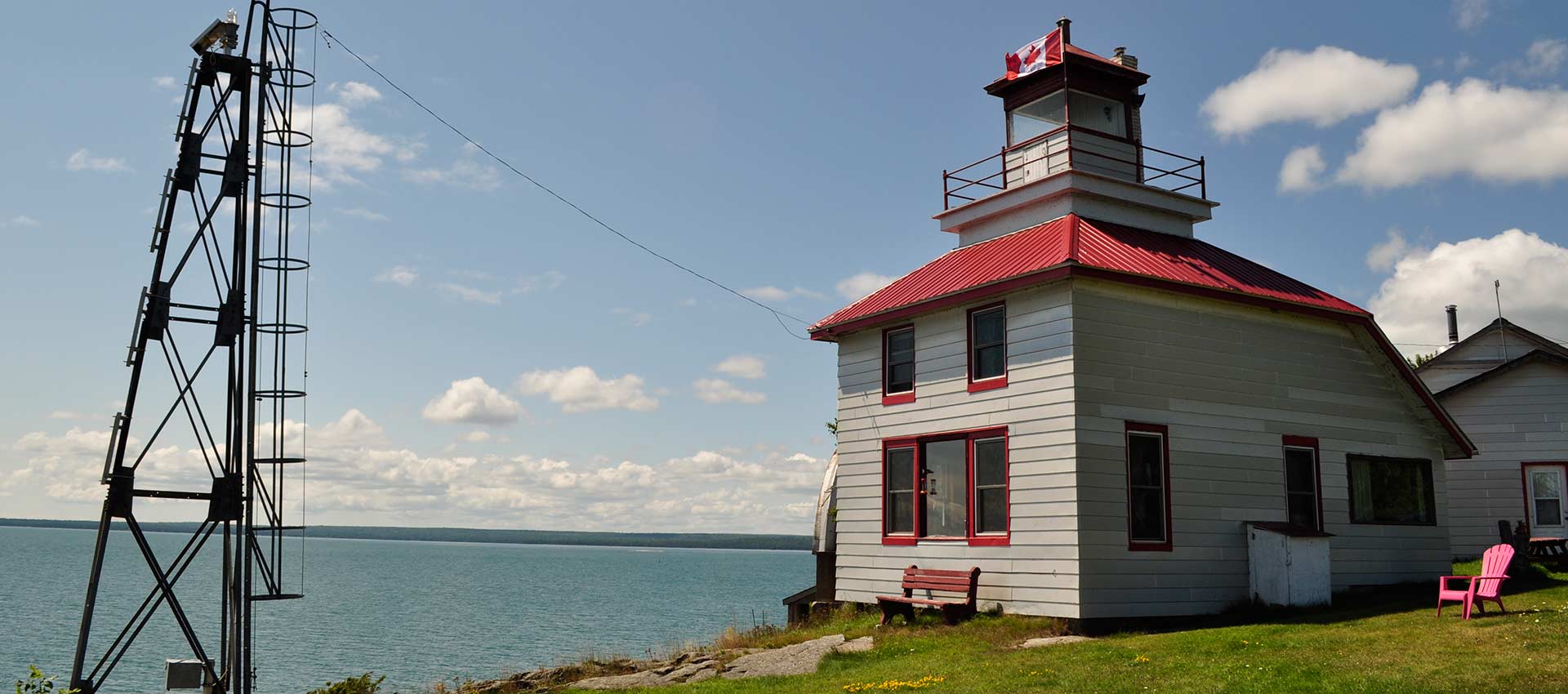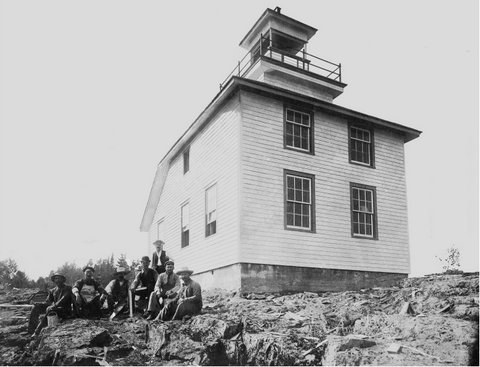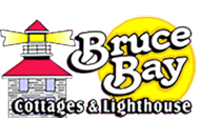
Lighthouse History
The harbour of Bruce Mines is horseshoe-shaped. It exists by the presence of three islands: French; McKay; Jacks. The mainland provides the north and west boundaries of the harbour. French and McKay islands provide the south boundary, and extend southeasterly. Jacks Island provides the east boundary and extends southward. The harbour’s entranceway is between the eastern tip of McKay Island and the southern tip of Jacks Island.
In 1902, the first navigation light at the harbour of the Town of Bruce Mines, Ontario was a relatively small lantern. The lantern was placed on the harbour’s wharf to guide the ships into the town’s new public wharf. The new wharf provided the ships with a deeper draft, more berthing space for the ships and a large storage shed for loading and unloading cargo. The new wharf was extended into the harbour by a 1,000 foot (300 m) causeway road. The lantern’s light was a dioptic (refractive) lens system that alternatively shone between white and red, and had a visibility of 5 miles (8 km). There was also a fog horn that was operated by a hand pump.

A new lighthouse was required due to an increase in marine traffic caused by the timber industry. Timber had replaced the copper mining industry as the main commercial activity in the area Surrounding Bruce Mines. This new lighthouse would be located within one acre (4,500 sq m) of the rock bluff at the most easterly tip of McKay Island. This location would be closest to the seaway’s main navigation channels. Also, it would mark a reef that extends eastward from McKay Island, right at the proposed location of the new lighthouse. This new lighthouse would be located approximately one nautical mile (1.6 km) from the public wharf at Bruce Mines.
McKay Island had several owners: Federal Government of Canada; Montreal Mining Company; Bruce Mines Copper Ltd.; Copper Mining and Smelting Co of Ontario, Ltd.
The McKay Island lighthouse was built in 1907 by the Canadian federal government.
Indenture # 902 (a deed or land grant) shows the lighthouse survey plans drawn on 1905 June 3 by Mr. James S. Dobie, Ontario Land Surveyor. On 1910 June 7, an indenture was executed by Bruce Mines Copper Ltd that transferred title of this small parcel of land to His Majesty King George V for $ 25.00. Indenture # 903 was registered on 1910 July 20.
The new lighthouse was accessible only during the navigation season by small watercraft. The lighthouse was constructed as a wood-framed residential dwelling. Its beacon tower extended from the roof to a height of 32.8 feet (10 metres) above water level. The access to the tower was via an internal staircase from within the residential dwelling. The beacon was a fixed dioptic lens system that used coal vapour for its source of illumination. The beacon’s light was visible for 10 miles (16 kms). The fog horn was hand cranked.
Later, the beacon’s illumination was converted to electricity that used sodium-sulphur batteries as its power source. The battery chest was located outside of the residential dwelling but sheltered within the porch to the main entrance door . The battery cells were housed within tall, square, heavy wall, glass containers.
Adjacent to the lighthouse, on the north side, was a boathouse that was close to the water’s edge. The boathouse was required to store the lightkeeper’s boat, hardware supplies, fuel, coal oil, fishing nets, plus gallons (litres) of paint, both white and battleship grey. This boathouse had an inclined ramp, complete with a hand-cranked winch, by which the lightkeeper could store his boat and re-launch it. The old boathouse superstructure has been removed, however, its foundation can still be seen.
The Keepers of the Light:
The main job for the keeper of the light was to keep the beacon’s lens well cleaned, fuelled (energized), lighted and extinguished at the proper times.
1907 – 1915:
Joseph Harvey – He was a faithful servant of the light until his death.
1915 – 1946 :
Angus James McNeish – born on April 7, 1881. He was a descendant from a family of miners from Cornwall, England. Many of the town’s residents were immigrants who had worked at the tin and copper mines of Cornwall, England.
1946 – 1947 :
Merritt Strum – born on 1924 January 28. Ontario Member of Provincial Parliament (MPP) Mr. Lynn Miller (also Town Mayor) approached Mr. Merritt Strum, a World War II Army veteran, about the job. The lighthouse keeper’s salary was $ 2.14 a month. Mr. Strum tended the light for one year, then went to work for Noranda Mines in Quebec.
1947 – 1953:
Gordon Inch – born on 1917 March 8. He was a World War II Army veteran.
1953 – 1955 :
Harold Wing -born 1909 July 21. The waters within the harbour could be rough. The water trips to the lighthouse by boat could be dangerous. During such events, Mr. Wing would drop his wife Eva and three children off at a sheltered landing on McKay Island. They would walk the last quarter mile (0.5 km) across McKay Island. Mr. Harold Wing would continue the journey to the lighthouse with his boat.
1955 Oct 1:
At the end of that navigation season, the lighthouse became uninhabited and the beacon light extinguished. From hereafter, the lighthouse would require only a part-time, non resident light keeper. He would activate the sodium-sulphur batteries, and set the beacon’s light timer control mechanism, at the start of the navigation season, and de-commission it at the end of the season.With the opening of the St. Lawrence Seaway, new Great Lakes freighters were designed and built to optimize the commercial potential offered by the new lock system. Huge cargo tonnages needed vessels of great length, beam and draft. The Bruce Mines harbour was relatively shallow. Also, the economic activity of Bruce Mines, and its surrounding area, could be fully satisfied via road transport. During the late 1950’s to early 1960’s, commercial ships no longer stopped at this wharf.
The primary purpose of the public wharf converted from commerce to public recreation. The wharf’s cargo shed was redundant and started to fall into disrepair. Mr. Merritt Strum, town citizen and local historian, saved the public wharf’s shed by having it moved to the town’s Agricultural Fair Grounds where it stands today.
In the late 1960’s, for cost reasons, the Canadian federal government decided to tear down the abandoned, dis-repaired lighthouse. The windows were broken and birds had made their nests inside the dwelling. There was no routine maintenance. However, the lighthouse beacon’s light was still required due to the increase in recreational boating. The Canadian government would replace the lighthouse with a beacon mounted atop a steel skeleton tower.
Mr. Harold D. Peterson, town resident, successfully negotiated with the Federal Government to reconsider the destruction of the old lighthouse by selling it to him. Mr. Peterson, not only was the owner of the rest of the McKay Island (and French Island), but wanted to preserve the landmark as a heritage. Both the Federal Government, and Mr. Harold D. Peterson, shared in the cost of installing electricity to McKay Island from the main power grid. It was also agreed that the beacon from the old lighthouse would never be lighted, as long as the replacement steel tower light existed.
Harold D. Peterson’s goal was to save the lighthouse structure, but in a modernized format that harmonized with its original appearance . In 1971, renovations began with Mr. Norman Beilhartz as the prime contractor. Mr. Beilhartz was a skilled carpenter, plumber and electrician. He was renown throughout the area both for his quality of craftsmanship and for his dedication to his client’s projects. He, his son James, together with Mr. James Gjos and Mr. Fred Gjos (two brothers from nearby Desbarats) renovated the lighthouse. Their carpentry work included handmade, knotty pine cupboards. The structure was fully electrified. A pressurized water system and septic system were also installed.
The steel tower was erected 1975 June 9 – 11. Mr. Rumley, from the Canadian Coast Guard, removed the illumination source from the lighthouse beacon’s lens. Then, he activated the steel tower’s beacon comprising white light, electric-powered, on a four second on-off blinking rate. The Canadian Coast Guard is responsible for the steel tower’s maintenance. The Canadian Coast Guard owns a very small square of land that comprises the footprint of the steel tower. Presently the beacon is an LED bulb that is operated by a solar panel. The Canadian Coast Guard maintain the bulbs and the solar panel.
In the late 1980’s, quarry operations of trap rock was resurrected after many decades and entered into viable, full commercial production. Great Lakes freighters began to load that cargo at a location just east of, and outside of, the Bruce Mines harbour. Today, this navigation beacon still guides sailing vessels, both the Great Lakes freighters into the Ontario Trap Rock wharf and recreational boats into the Bruce Mines harbour.
Presently the lighthouse is under the care of a member of the Peterson family, doing business as Bruce Bay Cottages and Lighthouse. The lighthouse is an all-season, self-catering lighthouse resort. You can still climb the ladder to the beacon’s rampart (quaintly referred to as the ‘widow’s walk’) for an amazing panoramic view of the North Channel of Lake Huron. Each season’s view is unique.
